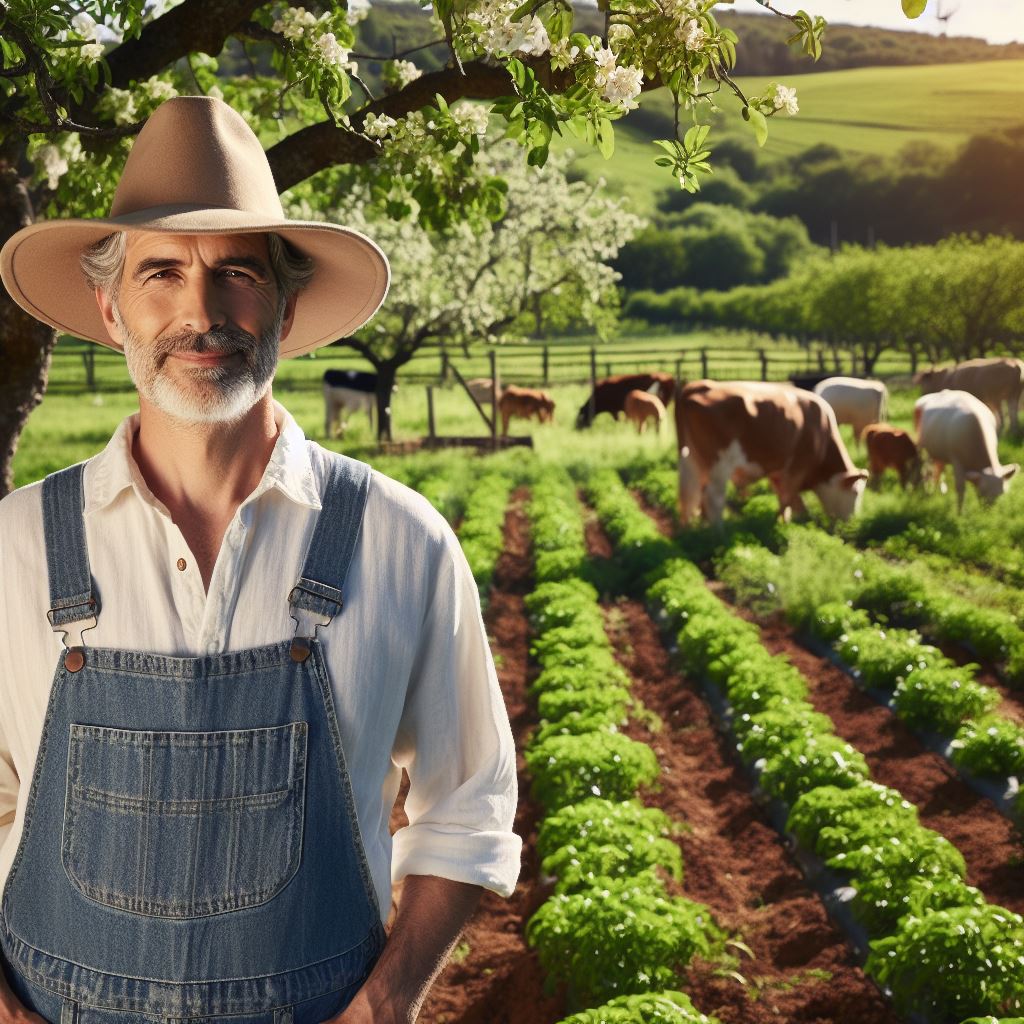Introduction
Let’s explore Agroforestry techniques: Sustainable farming tips.
Agroforestry is a farming method that combines trees with crops or livestock for sustainable production.
It plays a key role in addressing challenges like soil erosion, biodiversity loss, and climate change.
Sustainable farming techniques are vital to ensure food security, preserve natural resources, and promote long-term livelihoods.
By integrating trees, agroforestry provides multiple benefits such as improving soil fertility, enhancing water management, and increasing biodiversity.
Agroforestry systems also contribute to climate change mitigation by sequestering carbon dioxide through tree growth.
Furthermore, this approach offers economic opportunities by diversifying income sources through the sale of timber, fruits, or medicinal plants.
One example of an agroforestry technique is alley cropping, where rows of trees are planted between crops.
The trees provide shade, windbreaks, and organic matter when their leaves fall, resulting in improved soil structure.
Another technique is silvopasture, the combination of trees and forage crops for grazing livestock.
The trees offer shade, reduce heat stress, and provide additional forage during dry seasons.
Additionally, riparian forest buffers are established along water bodies to prevent soil erosion, filter pollutants, and improve water quality.
In short, agroforestry techniques provide sustainable solutions that integrate trees into farming systems, benefiting both the environment and farmers.
Benefits of Agroforestry
Agroforestry is a sustainable farming technique that combines agriculture and forestry practices, offering a wide range of benefits.
By integrating trees and crops, agroforestry creates diverse and productive ecosystems with positive environmental impacts.
Transform Your Agribusiness
Unlock your farm's potential with expert advice tailored to your needs. Get actionable steps that drive real results.
Get StartedHere are some of the key benefits of agroforestry:
Increased biodiversity
Agroforestry systems provide habitat for a variety of plants and animals, enhancing biodiversity on agricultural lands.
Trees attract beneficial insects, birds, and mammals that contribute to natural pest control and pollination.
Improved soil health and fertility
The presence of trees in agroforestry systems improves soil quality through various processes.
Tree roots help to hold the soil together, preventing erosion, while the fallen leaves and branches provide organic matter that enriches the soil and enhances its nutrient content.
Climate change mitigation
Agroforestry plays a crucial role in mitigating climate change. Trees in agroforestry systems sequester carbon dioxide from the atmosphere through photosynthesis, helping to offset greenhouse gas emissions.
Additionally, the shading effect of trees reduces heat stress on crops and livestock, minimizing their vulnerability to extreme weather events.
Conservation of water resources
Agroforestry practices promote efficient water use by reducing evaporation and improving water infiltration.
Trees act as windbreaks, reducing water loss due to evapotranspiration, and their dense root systems enhance soil permeability, reducing runoff and soil erosion.
This contributes to the conservation of water resources, particularly in areas prone to drought.
Economic benefits
Agroforestry systems offer various economic opportunities for farmers.
The integration of trees with crops or livestock diversifies income sources, reducing reliance on a single product.
Trees also provide additional products such as timber, fruits, nuts, and fodder, which can be sold or used for on-farm consumption.
Enhanced resilience to climate change
Agroforestry systems are more resilient to climatic variations and extreme weather events.
The presence of trees can buffer crops and livestock from temperature fluctuations, strong winds, and heavy rains.
In times of drought, trees access deeper water sources and provide shade, reducing moisture stress on crops.
Improved water quality
Agroforestry practices contribute to the improvement of water quality in surrounding ecosystems.
Tree roots filter pollutants, preventing them from reaching water bodies.
The shading effect of trees also helps to regulate water temperature, creating better conditions for aquatic life.
Enhancement of farm aesthetics
Agroforestry systems add aesthetic value to farmland. Trees provide visual appeal and create a pleasant environment for farmers, workers, and visitors.
The diverse array of plants and animals present in agroforestry systems can attract ecotourism, providing additional income opportunities for farmers.
Community benefits
Agroforestry can have significant positive impacts on local communities. By diversifying agricultural production and enhancing ecosystem services, agroforestry systems contribute to food security and income generation.
Moreover, the increased biodiversity and improved water and soil quality associated with agroforestry benefit not only farmers but also neighboring communities.
In fact, agroforestry techniques offer numerous benefits that contribute to sustainable farming practices.
Showcase Your Farming Business
Publish your professional farming services profile on our blog for a one-time fee of $200 and reach a dedicated audience of farmers and agribusiness owners.
Publish Your ProfileIncreased biodiversity, improved soil health, climate change mitigation, water resource conservation, economic opportunities, enhanced resilience, improved water quality, aesthetic appeal, and community benefits are just some of the advantages of implementing agroforestry systems.
By adopting these techniques, farmers can achieve agricultural productivity while also preserving the environment and supporting local communities.
Read: Diverse Farming: Agroforestry for Biodiversity
Types of Agroforestry Systems
Agroforestry is an innovative and sustainable farming practice that combines trees and agricultural crops.
It offers multiple benefits, such as increased crop productivity, soil conservation, and biodiversity promotion.
To implement agroforestry successfully, farmers need to understand the different types of agroforestry systems.
In this blog section, we will explore four common agroforestry techniques: alley cropping, silvopasture, windbreaks and shelterbelts, and forest farming.
Alley Cropping
Alley cropping involves planting rows of trees or shrubs alongside agricultural crops.
The planted trees provide shade, reduce erosion, and act as windbreaks.
The spaces between the tree rows are used for cultivating cash crops. This system allows for efficient use of land and enhances overall productivity.
Silvopasture
Silvopasture aims to integrate trees, forage, and livestock. It combines the benefits of forested areas with the production of pasture grasses and forage crops.
Trees provide shade for grazing animals while their leaves and branches contribute to nutrient cycling.
Silvopasture systems can improve animal welfare, increase forage production, and sequester carbon.
Windbreaks and Shelterbelts
Windbreaks and shelterbelts involve planting rows of trees or shrubs perpendicular to the prevailing wind direction.
They serve as barriers to reduce wind speed and protect crops and livestock from strong winds.
These systems also help control soil erosion, increase biodiversity, and enhance microclimate conditions.
Forest Farming
Forest farming refers to the cultivation of crops beneath a forest canopy.
This technique utilizes the shade-tolerant qualities of certain plants to grow crops such as mushrooms, medicinal herbs, or understory fruits and vegetables.
Forest farming promotes the efficient use of land, diversifies income sources, and contributes to ecosystem conservation.
Implementing agroforestry systems requires careful planning and consideration of local conditions.
Here are some key factors to keep in mind:
- Tree selection: Choose tree species that are suitable for the local climate, soil type, and desired benefits. Consider their growth rates, root systems, and compatibility with crops or livestock.
- Crop selection: Opt for crop varieties that can thrive in the shade or under tree canopies. Select crops that have a symbiotic relationship with trees, such as nitrogen-fixing plants that enhance soil fertility.
- Management practices: Regular maintenance, such as pruning, weeding, and pest control, is essential to ensure the success of agroforestry systems. Take into account the specific requirements of both trees and crops.
- Economic considerations: Assess the market demand and profitability of the selected crops and tree products. Explore potential value-added opportunities, such as processing or selling agroforestry products directly to consumers.
- Knowledge sharing and training: Engage with local agricultural extension services, research institutions, and experienced farmers to learn from their expertise. Participate in training programs or workshops on agroforestry techniques.
Agroforestry systems have the potential to transform traditional farming practices into more sustainable and resilient systems.
By integrating trees into agricultural landscapes, farmers can improve productivity, conserve natural resources, and enhance the overall agricultural ecosystem.
Embracing agroforestry techniques is a step towards a greener and more sustainable future.
Read: Climate Smart: Agroforestry Role in Farming
Agroforestry Techniques for Sustainable Farming
In order to promote sustainable farming practices, agroforestry techniques are gaining popularity.
These techniques involve integrating trees and crops in a synergistic manner to maximize benefits and minimize negative impacts.
Let’s explore some key agroforestry techniques that can be implemented on farms:
Planting nitrogen-fixing trees
Nitrogen is an essential nutrient for plant growth. By planting nitrogen-fixing trees like legumes, farmers can increase nitrogen levels in the soil naturally.
This reduces the need for synthetic fertilizers, thus promoting sustainable farming.
Selecting appropriate tree-crop combinations
Choosing the right combination of trees and crops is crucial for successful agroforestry.
Some trees provide shade, while others act as windbreaks or pest repellents.
Proper selection ensures that both trees and crops thrive together, creating a harmonious ecosystem.
Companion planting
Companion planting involves growing different plants together, with each providing benefits to the other.
For example, planting corn with beans can enhance soil fertility as beans fix nitrogen while corn provides support for the climbing beans. It’s a win-win situation for both crops!
Intercropping techniques
Intercropping refers to growing two or more crops simultaneously in the same field. It helps maximize land productivity by utilizing resources efficiently.
For instance, intercropping maize with pumpkins can improve soil moisture retention and increase overall crop yield.
Proper tree and crop spacing
Appropriate spacing between trees and crops is crucial to avoid competition for resources like sunlight, water, and nutrients.
It is important to strike a balance and provide enough space for each plant to grow optimally.
In addition to these techniques, there are a few more agroforestry practices that farmers can consider:
Showcase Your Farming Business
Publish your professional farming services profile on our blog for a one-time fee of $200 and reach a dedicated audience of farmers and agribusiness owners.
Publish Your ProfileAlley cropping
This technique involves planting rows of trees and crops alternatively.
The trees provide shade and protection to the crops, while the crops provide nutrient-rich mulch to the trees.
Windbreaks
Planting trees as windbreaks along field boundaries can help reduce wind erosion, soil degradation, and damage to crops.
This technique is particularly useful in areas with high wind intensity.
Silvopasture
Integrating trees with livestock grazing or forage production can enhance the productivity and sustainability of both.
Trees provide shade and shelter for animals, while their leaves can serve as nutritious fodder.
Agroforestry in water bodies
In areas with water bodies, planting trees along riverbanks or around ponds not only prevents soil erosion but also provides additional income through fisheries and other aquatic resources.
Agroforestry techniques offer numerous benefits to farmers and the environment.
They promote biodiversity, enhance soil quality, conserve water, and provide additional sources of income.
By adopting these techniques, farmers can contribute to a more sustainable future while ensuring their own economic well-being.
Read: Trees & Crops: Perfect Pair for Sustainable Farms

Maintenance and Management Tips
Pruning and Harvesting Trees
- Pruning is essential for maintaining tree health and controlling their growth.
- Regularly inspect and remove dead, damaged, or diseased branches to prevent pest and disease spread.
- Prune trees during their dormant period to avoid stress and excessive sap loss.
- Harvest trees at the appropriate time to ensure maximum yield and quality of products.
Weed Control and Mulching
- Implement effective weed control methods such as hand weeding, mulching, or mechanical cultivation.
- Mulching helps suppress weed growth, conserves soil moisture, and improves soil fertility.
- Use organic mulch materials like straw, wood chips, or leaves to provide additional nutrients to the soil.
- Maintain a weed-free zone around trees to reduce competition for resources and minimize pest issues.
Pest and Disease Management
- Monitor trees regularly for signs of pest infestations or disease symptoms.
- Employ integrated pest management (IPM) techniques such as biological control and cultural practices.
- Use organic pesticides as a last resort and follow recommended guidelines for their safe and effective use.
- Proper sanitation, including removing diseased plant material, helps prevent the spread of pests and diseases.
Irrigation and Water Management
- Provide adequate water to tree crops, especially during critical growth stages or dry periods.
- Use efficient irrigation systems like drip irrigation to reduce water wastage and ensure targeted water delivery.
- Monitor soil moisture regularly and adjust irrigation frequency and duration accordingly.
- Practice water conservation techniques such as rainwater harvesting or recycling of runoff water.
Soil Nutrient Management
- Conduct soil tests to determine nutrient deficiencies and adjust fertilization accordingly.
- Utilize organic fertilizers, such as compost or manure, to enhance soil fertility and improve long-term sustainability.
- Implement crop rotation or intercropping techniques to prevent nutrient depletion and increase soil nutrient availability.
- Incorporate cover crops that fix nitrogen or provide organic matter to improve soil health and structure.
Implementing these maintenance and management tips in agroforestry systems promotes sustainable farming practices, resulting in long-term environmental and economic benefits.
Read: Future Farms: How Agroforestry Shapes Tomorrow
Case Studies and Success Stories
Agroforestry techniques have gained widespread recognition for their ability to promote sustainable farming practices.
Several successful projects demonstrate the positive impacts of agroforestry on local communities and the environment.
Examples of successful agroforestry projects
The Swayambhu Community Forest, Nepal
- This project successfully implemented agroforestry techniques to restore degraded land and improve local livelihoods.
- By planting trees alongside crops, the community achieved increased agricultural productivity.
- The agroforestry system enhanced soil fertility, reduced erosion, and provided additional sources of income.
- The project created a sustainable model that boosted community resilience and improved the well-being of farmers.
The Barba Azul Nature Reserve, Bolivia
- Agroforestry practices were integrated into the reserve’s management strategy, providing multiple benefits.
- Local communities engaged in sustainable farming practices that protected biodiversity and supported their livelihoods.
- The introduction of agroforestry resulted in increased food security and diversified income sources.
- Farmers reported improved soil health and decreased dependency on chemical inputs.
The Keyline Farm, Australia
- This agroforestry project aimed to increase farm productivity while conserving natural resources.
- Implementing contour-based planting techniques enabled effective water management and improved soil moisture.
- The integration of trees into the farming system enhanced biodiversity, attracting beneficial insects and birds.
- Farmers experienced increased crop yields, reduced pest infestations, and minimized soil erosion.
The Ixcán Agroforestry Cooperative, Guatemala
- Through the establishment of an agroforestry cooperative, farmers achieved economic and environmental sustainability.
- The cooperative implemented multistrata agroforestry systems, combining crops, trees, and livestock.
- The integration of trees in the farming landscape enhanced biodiversity, restored degraded land, and improved carbon sequestration.
- Members of the cooperative reported increased incomes, reduced poverty, and improved food security.
The Miti Mingi Project, Kenya
- Agroforestry practices were utilized to address soil degradation and foster sustainable farming in rural communities.
- Farmers implemented the use of nitrogen-fixing trees to enrich the soil and replenish nutrients.
- The project resulted in improved crop yields, increased income generation, and enhanced resilience to climate change.
- Furthermore, the inclusion of trees provided sustainable sources of firewood, timber, and fodder.
In a nutshell, the case studies mentioned above demonstrate the successful implementation of agroforestry techniques in different regions of the world.
These projects have brought about positive impacts on local communities and the environment.
Agroforestry not only increases agricultural productivity and improves income generation but also fosters sustainability and resilience.
The integration of trees in farming systems enhances soil fertility, biodiversity, and carbon sequestration, while reducing erosion and chemical inputs.
By adopting agroforestry techniques, farmers can achieve sustainable farming practices, mitigate climate change, and improve the well-being of their communities.
These success stories serve as inspiration and evidence for the wide-scale adoption of agroforestry as a key solution for sustainable farming.
Conclusion
Agroforestry techniques provide numerous benefits such as increased soil fertility, biodiversity enhancement, and climate change mitigation.
Farmers should consider adopting agroforestry techniques to achieve sustainable farming practices and secure long-term benefits for themselves and the environment.
Agroforestry has the potential to play a crucial role in ensuring a sustainable future by offering solutions to address environmental, social, and economic challenges.




